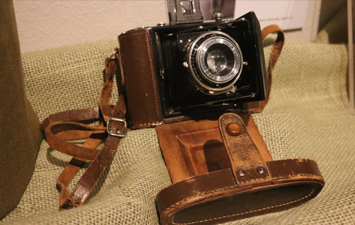
One of the most meaningful parts of working on World War II: The High Desert Home Front has been the opportunity to get to know veterans and their families. Our exhibit includes the stories, uniforms and personal belongings of four people who served during the war.
One of these soldiers is Hubert Croteau, a B-25 pilot. During his second mission, his plane was shot down over North Africa. Three of the men in his crew died in the crash. Croteau survived and was captured by German soldiers. They sent him to Stalag Luft III, a Nazi controlled camp for air force servicemen. Soon after, Hubert’s wife, Natalie, received a telegraph that he was missing in action. It would be another six weeks before she received news that Hubert was alive and had been taken prisoner.
Throughout Hubert’s imprisonment, he and Natalie exchanged letters, and Natalie sentpackages, including warm clothing. Despite the fact that conditions at Stalag Luft III were harsh—Hubert was often cold and hungry—the Nazi guards took pictures of the imprisoned Allied soldiers to prove that they were alive and in good health. Hubert sent one of these photos to Natalie. With it, she created a Christmas greeting that included a picture of herself inSpokane and Hubert in Stalag Luft III. This Christmas card is incredibly moving. Itis a testament to the strength of spirit of those on the front lines and those at home. After being imprisoned for 33 months, Hubert returned home and shared the next 64 years of his life with Natalie and their children.
Another favorite object is Harry Morioka’s camera. After spending a year incarcerated at the Tule Lake War Relocation Center, Harry was drafted into the U.S. Army’s unit of Japanese Americans. Because he was fluent in Japanese and English, he was selected for the Military Intelligence Service and stationed in Japan.
 While overseas, Harry traded two packs of cigarettes for a Zeiss Ikon camera. As part of his military duties, he traveled around Japan, taking pictures everywhere he went. He even found his extended family, who he had visited once as a young boy. One day Harry and a friend packed a Jeep full of food, water and treats. They traveled several hours to deliver the supplies to Harry’s family. Conditions in Japan at the end of the war were dire, and his family credited Harry with saving their lives.
While overseas, Harry traded two packs of cigarettes for a Zeiss Ikon camera. As part of his military duties, he traveled around Japan, taking pictures everywhere he went. He even found his extended family, who he had visited once as a young boy. One day Harry and a friend packed a Jeep full of food, water and treats. They traveled several hours to deliver the supplies to Harry’s family. Conditions in Japan at the end of the war were dire, and his family credited Harry with saving their lives.
In 1946, Harry returned home. Harry and his wife, Kazuko, began the work of rebuilding their lives in The Dalles—before being imprisoned at Tule Lake, they had sold their home at a fraction of its value. They repurchased the house, paying well above marketvalue. Harry opened a business and became an active part of the community.
The Christmas card and camera are so special because of the stories they tell—stories of love and connection in the midst of hardship and war. Today, Hubert Croteau’s and Harry Morioka’s families are keeping these stories alive. Through them, these objects have much to say about American’s experiences during the war.
